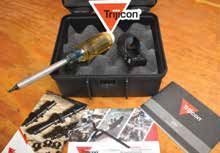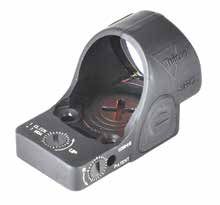The secret to shooting a handgun correctly has been boiled down to three words — Front Sight, Press. Anyone can line up the sights correctly. Anyone can activate a trigger. But can you line up the sights and then activate the trigger so that the alignment of the sights is not disturbed until the bullet leaves the muzzle? Then, add in the complicating factor that when the human mind feels the need to go fast, it wants you to look at the target, not the front sight. Stress does interesting things to your ability and your willingness to put your focus on the front sight. So does age. The military recognized this and started experimenting with the red dot–sight concept around 1970. Those concepts have been developed, tested, and accepted to the point where they are now standard equipment for almost everyone who carries a rifle in battle.
Those same principles work for shooters who feel the need for speed with a pistol, whether for self-defense, competition, or hunting. When using a red dot, keep both eyes open, look through the view-port, focus on the target, and superpose the red dot on the point of aim. That “activate the trigger smoothly” thing still comes up, but a red dot greatly simplifies aiming.
In the March 2020 issue, we provided a look at four modern everyday-carry (EDC) pistols with slide-mounted red dots. We compared accuracy and times required for various drills between the pistols and added in a comparison of some drills without the optics. The pistols that were red-dot equipped showed much higher scores than those without. Our methodology in that test was to use multiple pistols with the same or a very similar optic (Shield RMSc and SMSc). After publication, one of our readers contacted us and requested that, next time, we test red dots instead of the pistols. With that goal in mind, we selected a SIG Sauer X5 9mm Luger ($999) – currently one of the hottest pistols for the United States Practical Shooting Association’s (USPSA.org) Carry Optics division — as the test bed, along with a selection of red-dot sights, that would be appropriate for competition, hunting, or self-defense. Sights chosen were the Vortex Razor RZR-2003, $500; the Trijicon SRO SRO2-C-2500002, $750; the SIG Sauer Romeo 1PRO SOP1P101, $440; and the Crimson Trace CTS-1250 01-00560, $259.
How We Tested
We used a different testing routine than normal for this group. First, we did the testing with a single pistol with a single optic mounted over an extended period of time. We sighted in each red dot in turn, then shot them for groups at American Shooting Centers in west Houston. We shot the pistol/optic combo in practice for about a month, then finished everything off with a USPSA match.
Our biggest challenge/concern with the red dots has been mating them to the pistol. Rifles are well known for needing specific mounts for a specific model. We’re not sure why, but we never considered that before commencing this test, and we had issues. We needed an adapter to mount everything to the SIG X5. Even the SIG Romeo1Pro didn’t fit the SIG X5 without an adapter. Also, we found out the hard way that a SIG X5 and a SIG X5 Legion use different adapters! That required some careful work with a flat file.
We used Springer Precision (SpringerPrecision.com) for our adapter plates. Springer provided quick service and some great tech support, but we still had to improvise then find some extra 6-48 screws online. C&H Precision Weapons (chpws.com) also offers some adapters. The easy solution might be to look for a sight with the Docter pattern. Perhaps the manufacturers could post a list online of what adapters worked with which pistols? Could a more universal mount be created, as with a Picatinny rail? All things considered, we were impressed. We remember the early red dots when they were introduced to USPSA competitions in the late 1980s. What we tested here are light years ahead of those. To confirm our trust in this technology, our personal EDC, home defense, and competition pistols all mount good red dots.
We used the same Remington 115-grain 9mm ammo for all shooting tests. Here’s what we found:
Gun Tests Grade: A (OUR PICK)
$750
Trijicon, renowned for the effectiveness and durability of its products, directed its efforts towards the development of an optical pistol sight a number of years ago, resulting in the RMR (Ruggedized Miniature Reflex) sight. Further development has also brought us the SRO (Specialized Reflex Optic), which we included in this test. The SRO can be purchased with three different dot sizes (1, 2.5, and 5 MOA). We chose the 2.5.
| Weight | 1.6 oz. |
| Length | 2.2 in. |
| Width | 1.3 in. |
| Dot Size | 1, 2.5, or 5 MOA (2.5 tested) |
| Height Above Slide | 1.40 in. |
| Sight Window | Circular, 0.98 in. wide x 0.89 in. tall |
| Mount Type | Springer Precision Adapter |
| Battery Type | CR2032 |
| Battery Change | Top, unscrew slotted cover |
| Estimated Battery Life | 3 years at medium setting |
| Control Location | Both sides |
| Warranty | Limited lifetime |
| Telephone | (800) 338-0563 |
| Website | Trijicon.com |
| Made In | U.S.A. |
The SRO has a more rounded sight window that sits higher above the slide. We felt this higher sight picture brought the red dot into view more quickly than the others. The dot proved very easy to find as we presented the pistol from the draw. One of our testers opined that the SRO could also stand for “Suppressor Ready Optic.” The height above the slide on this model should clear the obstruction presented by many of the modern suppressors becoming so common on pistols intended for self-defense in the home. The Trijicon RMR (and the SRO as well since they have the same footprint) seems to have established itself as the default sight for which manufacturers mill their slides. Various (but not all) models of Glocks, the S&W Core, Canik TP9SFX, Walther Q5 Match, the Beretta APX, CZ P10, and select 1911s can all mount the SRO without an adapter.

Brightness controls are on the sides. Its use reminds us of an automatic transmission with a manual override. The SRO can be set to adjust automatically to changing light conditions. We found that to work pretty well. The shifts in intensity usually took less than a second and could be seen when we watched carefully. Even when standing in the shade and pointing the unit to a bright area or vice versa, we thought the SRO generally picked the right setting. The occasional exception appeared in very bright light. Sometimes we felt the dot should be a bit brighter.
Want to shift all the gears yourself? No problem. The auto adjustment can be locked out and you can make all your own decisions on the changes with eight possible settings — six daytime and two for nighttime use only. We would think the manual method would be more appropriate in a competitive situation, but the automatic might be very welcome in the home. Want to use the sight for multiple purposes on the same pistol? The SRO makes it easy to change modes for dot-intensity selection.
The housing is made of forged 7075 aluminum. Lenses are coated and tempered. You can feel the metal when you heft the sight. This little thing is built solidly, and you pay for that. Suggested list is $750. But then, do you think Trijicon learned anything about building a bullet-proof sight in 30 years of supplying combat Marines? Battery life is rated at three years with the dot set at medium intensity.

The unit is rated as waterproof to 10 feet. Windage and elevation controls are on the side and top, respectively, and can be adjusted with tools as common as a case rim or a coin. One click equals 1 MOA. The battery cover is located on the top deck immediately behind the glass. It has an X- shaped slot that we used a screwdriver to open. That method will scratch the cover up a bit, but that won’t matter as far as function is concerned. Many additional mounting options are available from Trijicon’s website (Trijicon.com). Please note that the glass on the SRO protrudes forward from the sight body a bit, and it is not recommended to mount the SRO if the front of the optic overhangs the chamber/breech face because this may cause the pistol to malfunction.
Our Team Said: The SRO offers bright 1.0-, 2.5-, or 5-MOA dots along with automatic or manual brightness controls. The tall sight window made the dot very easy to acquire and follow. This optic is built like a tank.



























